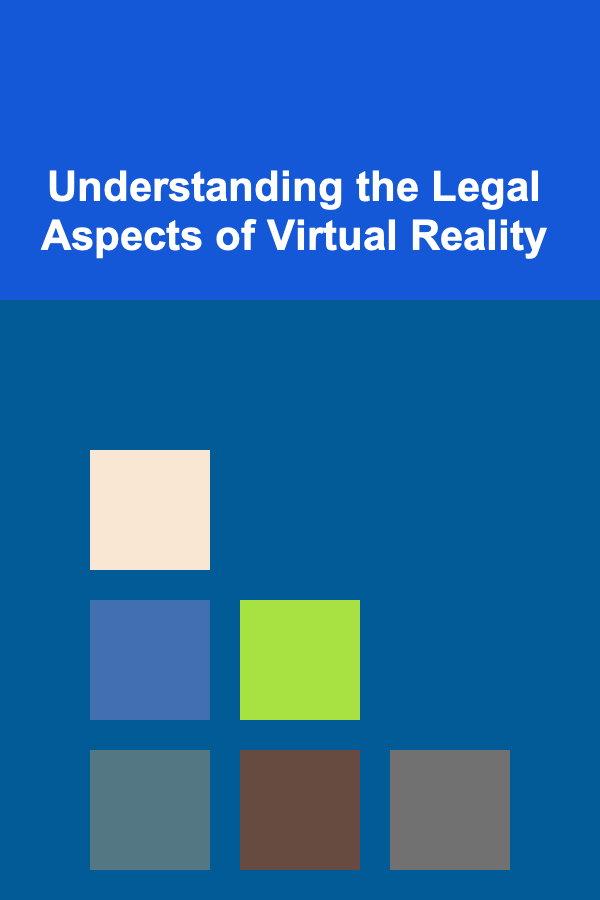
Understanding the Legal Aspects of Virtual Reality
ebook include PDF & Audio bundle (Micro Guide)
$12.99$8.99
Limited Time Offer! Order within the next:

Virtual Reality (VR) is rapidly evolving from a futuristic concept to a tangible reality, impacting entertainment, education, healthcare, and beyond. As VR technology becomes increasingly sophisticated and integrated into our lives, it raises complex legal questions that existing legal frameworks are often ill-equipped to address. Understanding these legal aspects is crucial for developers, users, and policymakers alike to navigate the opportunities and risks presented by this transformative technology.
I. Introduction to Virtual Reality and its Legal Challenges
Virtual Reality offers immersive, interactive experiences that blur the lines between the physical and digital worlds. This blurring creates unprecedented legal challenges across various domains, including intellectual property, data privacy, safety, liability, and jurisdiction. These challenges stem from the unique characteristics of VR, such as its ability to simulate realistic environments, collect biometric data, and induce powerful emotional responses.
Traditional legal principles, developed for the physical world and earlier forms of digital technology, may not adequately address the novel situations arising in VR. For example, how do we define the boundaries of personal space in a virtual environment? Who is responsible when a user causes harm to themselves or others while immersed in VR? How do we protect intellectual property in a medium where copying and distribution can be instantaneous and undetectable? These are just some of the questions that require careful consideration and potentially new legal approaches.
II. Intellectual Property Rights in VR
Protecting intellectual property (IP) in VR environments is a significant concern for content creators, developers, and rights holders. VR experiences often involve a complex combination of copyrighted works, including software code, 3D models, music, sound effects, and narratives. The ease with which these works can be copied, modified, and distributed in VR poses a significant threat to IP rights.
A. Copyright Issues
Copyright law protects original works of authorship fixed in a tangible medium of expression. In VR, this applies to the code that powers the experience, the visual and auditory elements, and the overall design. However, enforcing copyright in VR can be challenging. Consider the following:
- Infringement Detection: Identifying copyright infringement in VR can be difficult, as unauthorized copies may be subtly altered or embedded within larger experiences. Watermarking and digital rights management (DRM) technologies can help, but they are not foolproof.
- Fair Use and Transformative Use: The fair use doctrine allows for the limited use of copyrighted works for purposes such as criticism, commentary, news reporting, teaching, scholarship, and research. In VR, it can be difficult to determine whether a particular use is fair, especially if it transforms the original work in a creative or unexpected way. The courts will consider factors such as the purpose and character of the use, the nature of the copyrighted work, the amount and substantiality of the portion used, and the effect of the use upon the potential market for the copyrighted work.
- User-Generated Content (UGC): VR platforms often allow users to create and share their own content, which may incorporate copyrighted material without permission. This raises complex issues of liability for copyright infringement. The Digital Millennium Copyright Act (DMCA) provides a safe harbor for online service providers (OSPs) that comply with certain notice-and-takedown procedures, but this may not be sufficient to address all instances of infringement in VR.
B. Trademark Issues
Trademarks protect brands and logos that identify and distinguish goods and services. In VR, trademarks can be used to identify virtual products, experiences, and platforms. However, the use of trademarks in VR also raises potential issues of infringement and dilution.
- Virtual Goods and Services: Companies are increasingly offering virtual goods and services in VR, such as virtual clothing, virtual real estate, and virtual entertainment. Using a trademark to identify these virtual offerings is generally permissible, but it can be difficult to determine whether a particular use is infringing if it is confusingly similar to an existing trademark.
- Parody and Criticism: Trademarks can be used in parody or criticism, but this is subject to certain limitations. The use must not be likely to cause confusion or dilute the distinctiveness of the trademark. In VR, it can be difficult to determine whether a particular use is a legitimate parody or an infringing use.
- Metaverse and Brand Identity: As the metaverse evolves, the relationship between physical and virtual brands becomes more complex. Protecting brand identity across different virtual worlds and ensuring consistent messaging presents new challenges for trademark owners.
C. Patent Issues
Patents protect inventions that are new, useful, and non-obvious. VR technology relies on a wide range of patented technologies, including head-mounted displays, motion tracking systems, and haptic feedback devices. Patent infringement can occur if a VR product or service incorporates a patented invention without permission.
- Patent Thickets: The VR industry is characterized by a dense network of patents, which can make it difficult for companies to innovate without infringing on existing patents. This is known as a patent thicket.
- Standard Essential Patents (SEPs): Some patents are essential for implementing industry standards. These patents are often subject to licensing obligations on fair, reasonable, and non-discriminatory (FRAND) terms. However, disputes can arise over the interpretation and application of FRAND principles.
- Software Patents: Patenting software remains a contentious issue. Many VR innovations rely heavily on software, and the patentability of these innovations is subject to ongoing legal debate.
III. Data Privacy and Security in VR
VR systems collect vast amounts of personal data, including biometric data, gaze tracking data, and behavioral data. This data can be used to personalize the VR experience, but it also raises serious privacy concerns.
A. Types of Data Collected
VR systems can collect a wide range of data, including:
- Biometric Data: VR headsets can track eye movements, facial expressions, and other biometric data. This data can be used to infer information about a user's emotions, cognitive state, and even health conditions.
- Gaze Tracking Data: Gaze tracking data reveals where a user is looking in the VR environment. This data can be used to understand a user's attention, preferences, and even intentions.
- Behavioral Data: VR systems track a user's movements, interactions, and choices within the virtual environment. This data can be used to create detailed profiles of user behavior.
- Environmental Data: Some VR systems utilize cameras and sensors to map the user's physical environment, raising concerns about potential surveillance and data collection within the user's home.
B. Privacy Regulations
Various privacy regulations, such as the General Data Protection Regulation (GDPR) in Europe and the California Consumer Privacy Act (CCPA) in the United States, apply to the collection and use of personal data in VR. These regulations impose obligations on VR companies to:
- Obtain Consent: VR companies must obtain users' explicit consent before collecting and using their personal data. The consent must be informed, specific, and freely given.
- Provide Transparency: VR companies must provide users with clear and concise information about how their data is collected, used, and shared.
- Data Minimization: VR companies should only collect the data that is necessary for the specific purpose for which it is collected.
- Data Security: VR companies must implement appropriate security measures to protect personal data from unauthorized access, use, or disclosure.
- Data Retention: VR companies should only retain personal data for as long as it is necessary for the purpose for which it was collected.
- Right to Access and Delete: Users have the right to access their personal data and to request that it be deleted.
C. Security Risks
VR systems are vulnerable to various security risks, including:
- Hacking: VR systems can be hacked, allowing attackers to access sensitive data or manipulate the VR experience.
- Malware: Malware can be injected into VR environments, potentially infecting users' devices or stealing their data.
- Social Engineering: Attackers can use social engineering techniques to trick users into revealing personal information or performing actions that compromise their security.
- Deepfakes and Identity Theft: VR environments could be used to create deepfakes or impersonate individuals, leading to identity theft or other forms of fraud.
- Physical Security Risks: The immersive nature of VR can make users vulnerable to physical security risks, such as tripping or bumping into objects in the real world.
IV. Liability and Safety in VR
The immersive and interactive nature of VR raises complex issues of liability and safety. Who is responsible when a user causes harm to themselves or others while immersed in VR?
A. Negligence
Negligence is a legal concept that imposes liability for harm caused by a failure to exercise reasonable care. In VR, negligence claims could arise in various situations, such as:
- Defective Products: VR headsets or other VR equipment could be defective, causing injury to users.
- Negligent Design: VR environments could be designed in a way that creates unreasonable risks of harm, such as tripping hazards or flashing lights that trigger seizures.
- Failure to Warn: VR companies could fail to warn users about the potential risks of using VR, such as motion sickness, eye strain, or disorientation.
- Inadequate Supervision: In some cases, VR experiences may require supervision to prevent users from harming themselves or others.
B. Product Liability
Product liability law imposes liability on manufacturers and sellers for injuries caused by defective products. In VR, product liability claims could arise from defects in VR headsets, controllers, or other VR equipment.
- Manufacturing Defects: A manufacturing defect occurs when a product deviates from its intended design.
- Design Defects: A design defect occurs when a product's design is inherently dangerous, even if it is manufactured correctly.
- Failure to Warn: A failure to warn claim arises when a manufacturer fails to provide adequate warnings about the potential risks of using a product.
C. User Behavior and Responsibility
While companies have a responsibility to ensure the safety of their products and services, users also have a responsibility to use VR responsibly. This includes:
- Following Instructions: Users should carefully read and follow all instructions and warnings provided by VR companies.
- Taking Breaks: Users should take regular breaks to avoid motion sickness, eye strain, and disorientation.
- Awareness of Surroundings: Users should be aware of their physical surroundings while using VR and take steps to avoid tripping or bumping into objects.
- Avoiding Distracted Use: Users should avoid using VR while driving, operating machinery, or performing other tasks that require attention.
D. Virtual Assault and Harassment
VR environments can also be a platform for harassment and assault. The sense of presence in VR can make these experiences feel very real, even though they occur in a virtual space.
- Defining Virtual Harm: Establishing legal definitions for virtual assault and harassment is challenging. While physical contact is absent, the psychological impact can be significant.
- Responsibility of Platform Providers: VR platform providers have a responsibility to create safe and inclusive environments. This includes implementing policies against harassment, providing reporting mechanisms, and taking action against perpetrators.
- Content Moderation: Moderating content in VR is more complex than in traditional online environments. Real-time intervention and automated systems may be necessary to prevent harassment and abuse.
- Jurisdictional Issues: Determining jurisdiction in cases of virtual assault and harassment can be complicated, especially if the perpetrator and victim are located in different countries.
V. Jurisdiction and Choice of Law in VR
VR experiences are often accessed by users from different countries, raising complex issues of jurisdiction and choice of law. Which country's laws apply to a particular VR transaction or dispute?
A. Jurisdiction
Jurisdiction refers to the power of a court to hear and decide a case. In VR, jurisdiction can be determined based on various factors, such as:
- Location of the Defendant: A court may have jurisdiction over a defendant if the defendant is located in the court's jurisdiction.
- Location of the Plaintiff: A court may have jurisdiction over a defendant if the plaintiff is located in the court's jurisdiction and the defendant has sufficient contacts with that jurisdiction.
- Location of the VR Server: A court may have jurisdiction over a defendant if the VR server is located in the court's jurisdiction.
- Location of the Harm: A court may have jurisdiction over a defendant if the harm occurred in the court's jurisdiction.
B. Choice of Law
Choice of law refers to the rules that determine which country's laws apply to a particular case. In VR, choice of law can be determined based on various factors, such as:
- Contractual Choice of Law: The parties to a VR transaction may agree in their contract which country's laws will govern the transaction.
- Most Significant Relationship: In the absence of a contractual choice of law, the court will apply the law of the country with the most significant relationship to the transaction.
- Place of Injury: In tort cases, the court may apply the law of the country where the injury occurred.
C. Enforceability of Judgments
Even if a court has jurisdiction over a VR case and applies the appropriate choice of law, it can still be difficult to enforce the judgment if the defendant is located in a different country. International treaties and agreements can help to facilitate the enforcement of judgments across borders, but these treaties are not always applicable to VR cases.
VI. Regulatory Landscape and Future Trends
The legal and regulatory landscape surrounding VR is still evolving. Governments and regulatory agencies around the world are grappling with how to address the unique challenges posed by this technology.
A. Current Regulatory Efforts
Some examples of current regulatory efforts include:
- Data Privacy Regulations: GDPR and CCPA are influencing how VR companies collect and use personal data.
- Consumer Protection Laws: Consumer protection laws are being applied to VR transactions to protect consumers from fraud and deception.
- Industry Self-Regulation: VR companies are developing self-regulatory standards to address issues such as safety, privacy, and content moderation.
B. Potential Future Regulations
Potential future regulations could address issues such as:
- Virtual Property Rights: Regulating the ownership and transfer of virtual property in VR.
- Virtual Taxation: Taxing virtual goods and services in VR.
- Virtual Identity: Establishing rules for virtual identity and authentication in VR.
- Liability for AI in VR: Addressing liability issues related to the use of artificial intelligence in VR environments.
- Ethical Guidelines for VR Research: Establishing ethical guidelines for research involving VR technology, particularly concerning psychological effects and data privacy.
C. The Role of Technology
Technology itself can play a role in addressing some of the legal challenges in VR. For example:
- Blockchain Technology: Blockchain technology can be used to verify the authenticity of digital assets and to track the ownership of virtual property.
- Artificial Intelligence: AI can be used to moderate content and to detect and prevent harassment in VR environments.
- Biometric Authentication: Biometric authentication can be used to verify the identity of users in VR.
- Privacy-Enhancing Technologies (PETs): PETs can be used to protect user privacy while still allowing VR systems to collect and use data. Examples include differential privacy and homomorphic encryption.
VII. Conclusion
Understanding the legal aspects of VR is essential for navigating the opportunities and risks presented by this transformative technology. The legal landscape is still evolving, and new challenges will undoubtedly emerge as VR technology continues to advance. By staying informed about the legal developments in this area, developers, users, and policymakers can help to ensure that VR is used responsibly and ethically.
Addressing the legal challenges of VR requires a multi-faceted approach, involving collaboration between lawyers, technologists, policymakers, and the VR community. This collaboration is crucial to developing legal frameworks that are both effective and adaptable to the rapidly changing nature of VR technology.
Ultimately, the goal is to create a legal environment that fosters innovation and protects the rights and interests of all stakeholders in the VR ecosystem.

Expert Bargain Hunting Strategies for Scoring the Best Deals
Read More
How to Create an Efficient Virtual Workspace Setup
Read More
How to Develop AI for Climate Change Solutions
Read More
How To Choose the Perfect Denim for Your Body Type
Read More
How To Master Pop Piano Chords: A Deep Dive
Read More
How to Determine the True Cost of a Private Education
Read MoreOther Products

Expert Bargain Hunting Strategies for Scoring the Best Deals
Read More
How to Create an Efficient Virtual Workspace Setup
Read More
How to Develop AI for Climate Change Solutions
Read More
How To Choose the Perfect Denim for Your Body Type
Read More
How To Master Pop Piano Chords: A Deep Dive
Read More